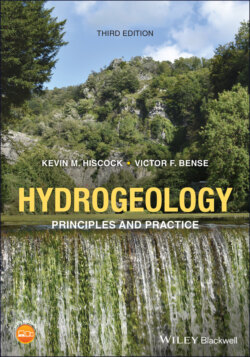Читать книгу Hydrogeology - Kevin M. Hiscock - Страница 28
1.5.4 Global groundwater material and elemental fluxes
ОглавлениеAs an agent of material transport to the oceans of products of weathering processes, groundwater probably represents only a small fraction of the total transport (see Table 1.2). Rivers (89% of total transport) represent an important pathway while groundwater accounts for a poorly constrained estimate of 2% of total transport in the form of dissolved materials (Garrels et al. 1975). Estimates by Zektser and Loaiciga (1993) indicated that globally the transport of salts via direct groundwater discharge is approximately 1.3 × 109 t a−1, roughly equal to half of the quantity contributed by rivers to the oceans. Given a volumetric rate of direct groundwater discharge to the oceans of 2220 km3 a−1, the average dissolved solids concentration is about 585 mg L−1. This calculation illustrates the long residence time of groundwater in the Earth's crust, where its mineral content is concentrated by dissolution.
In an analysis of comprehensive datasets of the chemistry of groundwater and produced water (groundwater pumped during oil and gas extraction) compiled by the US Geological Survey (DeSimone et al. 2014; Blondes et al. 2017), together with estimates of global groundwater usage, Stahl (2019) estimated elemental fluxes from global pumping and found that groundwater fluxes contribute appreciably to the overall cycles of a number of important elements and may provide a significant portion (more than 10%) of crop requirements of key nutrients (e.g. potassium and nitrogen) where groundwater is used for irrigation. Comparing the dissolved solute flux from groundwater pumping to the dissolved solute flux of approximately 4–5 × 109 t a−1 delivered annually to the ocean by rivers (Sen and Peucker‐Ehrenbrink 2012), Stahl (2019) calculated that total pumping with and without produced waters gives fluxes of total dissolved solids (TDS) of 881 × 106 and 513 × 106 t a−1, respectively, which represent 20 and 7% of the global dissolved solute flux carried by rivers. The fact that groundwater and produced water pumping are exclusively anthropogenic fluxes of water highlights the significance of groundwater pumping in global elemental cycles.
Table 1.2 Material transport and subsurface dissolved salts discharge from groundwater to the world's oceans (Garrels et al. 1975 and Zektser and Loaiciga 1993).
(Sources: Garrels, R.M., Mackenzie, F.T. and Hunt, C. (1975) Chemical Cycles and the Global Environment: Assessing Human Influences. Kaufman, Los Altos, California; Zektser, I.S. and Loaiciga, H.A. (1993) Groundwater fluxes in the global hydrologic cycle: past, present and future. Journal of Hydrology 144, 405–427.)
| Agent or Ocean | % of total material transport (Remarks) | % of total dissolved salts transport | Subsurface dissolved salts discharge (106 t a−1) |
|---|---|---|---|
| Surface runoff | 89 (Dissolved load 19%, suspended load 81%) | 66 | – |
| Glacier ice, coastal erosion, volcanic and wind‐blown dust | ∼9 (Ice‐ground rock debris, cliff erosion sediments, volcanic and desert‐source dust) | – | – |
| Groundwater | 2 (Dissolved salts similar to river water composition) | 34 | – |
| Pacific | – | 520.5 | |
| Atlantic | – | 427.8 | |
| Mediterranean Sea | – | 42.5 | |
| Indian | – | 295.5 | |
| Arctic | – | 7.2 | |
| All oceans | 1293.5 |
